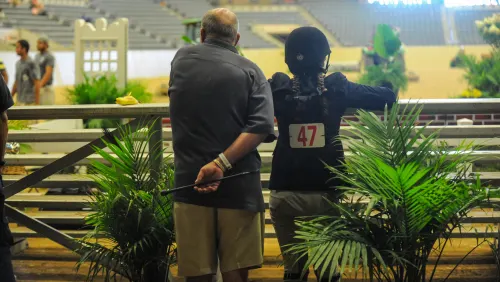All horse sports, if practiced correctly, are a never-ending learning experience. But eventing probably has the longest learning curve because the three disciplines’ demands prevent practitioners from ever getting really good at dressage or show jumping. And, for some people, the fact that there’s so much to comprehend is a good reason not to aspire higher. But if you become good enough at jumping and dressage that you put together a series of clear rounds and start collecting ribbons (especially blue), soon your friends and acquaintances will begin asking when you’re going to move up.
Stepping up to the next level, though–whether from beginner novice to novice, novice to training, or training to preliminary or higher–depends on four factors, each of basically equal weight.
First is your personality. Are you a risk-taker? Are you an achiever, someone who must constantly test themselves (or their training)? Or do you prefer to keep your life steady and comfortable? If you’re happy with things the way they are, the next three factors would have to be rather overwhelming to provoke you to make that giant leap.
Second is your life. Are your career, family and finances in a position to do more with your horse? Risk-takers will always answer yes, but they also might go bungee jumping in Acapulco. The difference in the financial and time investments between beginner novice and training aren’t drastic (depending on your own and your horse’s athleticism), but moving to preliminary or above brings you to a new realm of time and financial commitment, which your life and the other people in it may or may not be able to bear.
Third is your horse, as Denny Emerson eloquently notes in his Between Rounds column (p. 40) and as Kim Morani, Gretchen Butts, Lellie Ward and Cricket Worthen prove in our story about their planned assault on the Burghley CCI**** (p. 8). To progress to a higher level, you simply have to have a horse with the jump and the gallop to do it. And to jump at preliminary or higher, you have to feel as if you could jump together through a flaming hoop or off Niagara Falls.
ADVERTISEMENT
And, fourth, you have to have a coach you can trust, especially if, like most of us, you’re an amateur. You have to work with someone who has strategic vision and creativity in their training, someone who can challenge you and stretch you and your horse in lessons with exercises you never, ever would have dreamed of doing yourself. But they put you through these exercises at the right time, in a controlled, repeatable situation, and then, when you get to the competition, you’re so confident that the jumps look and ride easy.
Yes, I think these factors are equal, but the straw that stirs the drink is coaching. You could have the horse to move up, but not know it or believe it because you’re weighted down by how horrible your horse used to be or because you just never imagined yourself doing more.
But pretty soon that medium canter down the long side feels so powerful and soft. Then that double of corners that once left you sleepless just seems to happen, straight and true. And, holy cow, your horse extends and shortens from your leg and seat in the triple combination, and the rails stay up.
Really, though, it doesn’t matter whether you’ve done those things at a new level or at the level where you’re happy. What really matters is that you and your horse have reached a new level of communication that’s allowed you to do it together.














